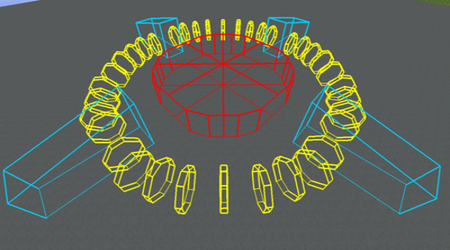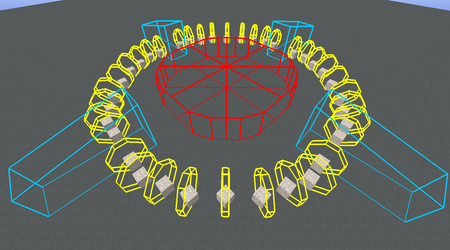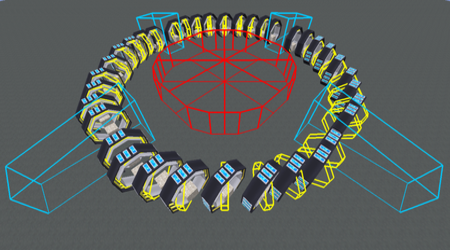ON THIS WIKI
Tutorial:Fusion Reactor (ReactorCraft)

|
This article is part of the Modded Minecraft Wiki's Tutorials section. |
The purpose of this tutorial is to explain the construction, usage, and purpose of the Fusion Reactor from the ReactorCraft mod. This tutorial describes in detail how the Fusion Reactor works and how to operate and maintain it. A Fusion Reactor is a large energy generation machine. It uses the power of Nuclear Fusion to create heat energy. This may sound complex but hang in there, its much simpler than it seems. The heat generated by Fusion is used to boil water into steam which is then used to spin a turbine. In essence the only difference between a coal boiler and a fusion reactor is where the heat comes from.
How Does Fusion Work?[edit]
In nuclear fusion, two atoms, are fused together under extreme heat and pressure. Through this process some mass is lost, which releases heat and a fast-moving neutron. This neutron carries a large amount of energy from the fusion reaction and must be caught to utilize its energy. In a Fusion Reactor the Hydrogen isotopes Deuterium and Tritium are fused together under extreme temperatures to produce a Fusion Plasma. The Fusion Plasma releases neutrons as we discussed previously, which in a Fusion Reactor are captured and converted into heat energy.
Nuclear Fusion occurs in a similar fashion in our star, the Sun, which produces energy as electromagnetic radiation which is made up of light, heat energy, ultraviolet light, radio waves, and a stream of particles.
Tokamak Fusion Reactor[edit]
The Fusion Reactor is composed of four crucial parts, each serving important specific roles in the operation of the reactor. Beyond the four primary parts of the reactor lay neutron capture and steam generation. The function of the reactor parts is described in detail below.
Toroid Magnet[edit]
The Toroid Magnet is a circular ring that concentrates the Fusion Plasma into a narrow beam in its center. A total of 36 Toroid Magnets are placed in a circle that the plasma will travel around as it releases neutrons.
The Toroidal Magnets use an electromagnetic field to prevent the Plasma from touching the walls of the Toroid Magnet, which would cause it to melt. To provide the Toroid Magnet with an electromagnetic change, a Van De Graaff Generator must be placed below one of the magnets and powered properly. The charge will carry from magnet to magnet, getting weaker each time. Once the charge become too low to transfer enough energy to the next magnet, a new Van De Graaff Generator must be placed. This can be visually determined when the purple charges turn color to green, white, and yellow.
The heat of the Fusion Plasma makes the Toroid Magnet very hot. In order to keep the magnet functional it must be keep very cold. Liquid Nitrogen is the coolant fluid for the magnets. Liquid Nitrogen is fairly difficult to obtain in large enough quantities for the rate at which the magnets use it. (Get a more precise number for this). Be sure to have a way to generate it fast enough. Liquid Nitrogen can only transported in Liquid Pipes to the top of a toroid magnet.
You Will Need[edit]
| Item | Amount |
|---|---|
| |
36 |
| |
4 |
[edit]
The use of a Tokamak Blueprint Highlighter is suggested as it makes placing the Toroid Magnets much easier. 
[edit]
Put a temporary block on each of these spots marked by the highlighter. 
[edit]
Put a Toroid Magnet on each one of the temporary blocks. 
[edit]
You may have noticed that each magnet had an arrow pointing north. This arrow must point to the center of the circle formed by the magnets. To change the direction of the magnet, right+click on it with a Screwdriver to rotate it counter-clockwise or shift+right+click to rotate it clockwise. File:Fusion4.png
[edit]
Place Liquid Pipes above each magnet. Avoid placing a Pipe "inside" the toroid magnet, be sure to keep the inner area clear. These pipes will eventually hold the Liquid Nitrogen to cool the magnets.
[edit]
In this empty space between Toroid Magnet sections where the blue lines are, place a Fusion Plasma Injector. Be sure to face it in one direction only, the direction doesn't matter. This part will become important later, but for now it is used to allow electric charges to jump from one side to another as described in detail below.
[edit]
Clear a space underneath the magnets. Starting underneath any magnet, place a Van De Graaff Generator. Refer to the Van De Graaff Generators page on how to fulfill its power requirements. After the Van De Graaff is powered you will notice that the Toroid Magnets occasionally display a purple electric charge jumping from one to another. Watch each one to make sure that the charge jumping from magnet to magnet (Note that the electric charge will also jump to and from the Fusion Plasma Injector.) is still purple. Once you see an electric charge that is not purple, place another Van De Graaff Generator beneath the Toroid Magnet prior to the different charge color. Repeat the steps taken to power the first Van De Graaff. Repeat this process until the entire ring of Toroid Magnets are electrically charged.
Alternatively, if you have Waila installed, you can see the current charge of the Toroid Magnet. The charge value must be over 1000V for the Fusion Plasma to be contained.
Congratulations, the Toroid Magnets are now correctly set-up and ready to be functional. You may turn off each Van De Graaff Generator, they do not need to be on while the Reactor is being constructed.
Solenoid Magnet[edit]
The Solenoid Magnet is a much more difficult contraction to construct than the Toroidal Magnets. The Solenoid Magnet spins at a high velocity to force the Fusion Plasma in the Toroid Magnets to move around the reactor in a circle. Without the Solenoid Magnet, Fusion Plasma would not stay in the Toroid Magnets and no heat energy would be captured.
You Will Need[edit]
| Item | Amount |
|---|---|
| |
1 |
| |
17 |
| |
40 |
| |
20 |
| |
40 |
| |
28 |
| |
56 |
[edit]
To get started, place a Solenoid Magnet on top of the Tokamak Blueprint Highlighter.
[edit]
Surround the top half of the Solenoid Magnet with 17 Solenoid Hubs.
[edit]
From the bottom layer of Solenoid Hubs, place 6 Hysteresis Rods in each cardinal direction and 4 diagonally from the corners.
[edit]
Place 5 Central Permanent Magnets perpendicular to the cardinal Hysteresis Rods.
[edit]
Place a Ferromagnetic Base above and below every Central Permanent Magnet.
[edit]
Place the Auxiliary Permanent Magnets as depicted below
[edit]
Place Magnetic Linkage above and below every Auxiliary Permanent Magnet.
[edit]
Once the last Magnetic Linkage is placed the Multiblock structure will form. This means that the Solenoid Magnet is fully constructed. However, the Solenoid Magnet still needs to spins. Going underneath the Solenoid, target the center of the Solenoid Magnet, where the Solenoid Magnet block was placed. You will need to supply this block with 62.768 kNm and 256.000 rad/s. A simple set-up for this: Gas Turbine --> Bedrock 2:1 Gearbox --> Bedrock 16:1 Gearbox --> Bevel Gears --> Bedrock Shaft --> Solenoid Magnet. The gearboxes and shafts can be of diamond quality, but they require 1 bucket of Lubricant each. Bedrock tier gearboxes and shafts do not require Lubricant.
Important: Breaking any part of the Solenoid Magnet while it is spinning will cause it to explode, sending pieces of it and the ground flying outwards.
Plasma Injector[edit]
The Plasma Injector is the machine that injects the Fusion Plasma from the Hydrogen Preheater Unit into the ring of Toroid Magnets. A Fusion Reactor can have up to four Plasma Injectors, but needs at least one to operate (Confirm this). More Plasma Injectors means that more Plasma will be concentrated into the Toroid Magnets. A higher Plasma concentration means that more neutrons will be emitted, generating more heat energy for steam generation.
You Will Need[edit]
| Item | Amount |
|---|---|
| |
1 per, 4 total |
| |
9 per, 36 total |
| |
18 per, 72 total |
| |
8 per, 32 total |
| |
9 per, 36 total |
| |
18 per, 72 total |
| |
11 per, 44 total |
| |
32 per, 128 total |
| |
3 per, 12 total |
Begin around the previously placed Fusion Plasma Injectors. Underneath the Injector piece place 9 Plasma Injector Bases. Place Plasma Injector Lower Corner pieces on both sides of the Injector Base. On the side facing the Solenoid Magnet place a three tall column of Plasma Injector Column Pieces on each side. On the back place one Column piece on each side. Place nine Plasma Injector Tops as displayed below. Place Plasma Injector Upper Corner pieces on both sides of each Injector Top piece. Connect some Magnetic Containment Pipes to the Fusion Plasma Injector. This pipe will carry Fusion Plasma from the Hydrogen Preheater Unit to the Plasma Injector. Fill in the center layer with Plasma Injector Hysteresis Cores. Fill the outside layers with Plasma Injector Side Panels. Do not place Side Panels in front of or behind the Plasma Injector. Place three Plasma Injector Induction Coils in the empty space on the front on the Plasma Injector. If the front of the Plasma Injector changes texture then it was correctly assembled. The Induction Coils must be placed last for the structure to form.
After the structure is complete, connect the Liquid Pipes found on both sides of the Injector.
It is not necessary for all four Plasma Injectors to be built, but doing so does increase the injected plasma, which in turn increases neutron output, which is what generates heat to make steam to spin a turbine.
Hydrogen Preheater Unit[edit]
The Hydrogen Preheater Unit is the device that fuses the hydrogen isotopes Deuterium and Tritium to create Fusion Plasma. In our Sun, fusion of hydrogen isotopes occurs under massive heat and pressure. Unfortunately the extreme pressure in the core of the Sun is impossible to replicate on Earth. To overcome the inability to replicate the pressure, the temperature in the Hydrogen Preheater Unit must be 10x the temperature in the core of the Sun, coming to a total of 150 million degrees Celsius. A Heat Ray is used to heat the Plasma to this temperature.
Unlike the previous three parts, the position of the Hydrogen Preheater Unit does not matter. A reactor only requires one, but more can be constructed to shorten the distance the Fusion Plasma needs to travel to get to the Plasma Injector.
You Will Need[edit]
| Item | Amount |
|---|---|
| |
12 |
| |
40 |
| |
42 |
| |
30 |
| |
2 |
| |
1 |
| Hydrogen Preheater Unit Construction |
|---|
If the texture on the Preheater Unit does not change, you may need to break and replace the Laser Concentration Lens.
The two separate Liquid Pipes carry Deuterium and Tritium to the Hydrogen Preheater. The Deuterium and Tritium should not be stored in Reservoirs because the gas is so lightweight, it will dissipate into the air. To heat the Hydrogen Preheater to the proper temperature a Heat Ray must be pointed at the Laser Concentration Lens and powered at 2.097 MW. Using an Angular Transducer on any block of the Hydrogen Preheater Unit will display its current temperature. For fusion to occur the temperature must be 150 million degrees Celsius.
The Magnetic Containment Pipe that connects the Hydrogen Preheater and the Plasma Injector must be electrically charged to keep the plasma away from its walls, otherwise it would melt. A Van De Graaff Generator is used to electrically charge the Magnetic Containment Pipe.
Turbine[edit]
A set of Turbines is one of the ways to convert Steam into rotational energy. Steam must flow openly into the turbine using a Steam Grate to be expelled from the exterior. The turbine is easily damaged due to the direct exposure of the blades. The power output of a regular set of turbines is unstable and can be stabilized by constructing a Turbine Flywheel. More information on setting up a turbine can be found on the Turbine page.
High-Pressure Turbine[edit]
The High-Pressure Turbine is by the superior choice in turbine choice. It has a protective layer over the turbine blades to prevent accidental damage. Steam is pumped into the turbine directly, eliminating the need for a Steam Grate. The Power output of the High-Pressure Turbine remains stable once it has fully sped up. More information on setting up a High-Pressure Turbine can be found on the High-Pressure Turbine page.
Turbine Generator[edit]
The Turbine Generator is an optional step that takes a turbines rotational power and converts it to Redstone Flux (RF). This is incredibly useful for transporting the power to other locations and for powering machines from other mods. This feature is dependent on Thermal Foundation.
Steam[edit]
Two fluids can become steam in the Fusion Reactor; Water and Ammonia. Water is much easier to obtain in larger quantities but produces less. While Ammonia is much harder to come by, it produces more power in a turbine.
| Fluid | Turbine Watt Production | High-Pressure Turbine Watt Production | Turbine Generator RF Conversion |
|---|---|---|---|
| Water | ~920 MW - ~950 MW | 8.590 GW (8590000 kW) | 16,519,104 RF/t |
| Ammonia | ~1.9 GW (1900000 kW) | 12.780 GW (12780000 kW) | 24,576,000 RF/t |
- Results collected at turbine max size and speed.
Starting Up[edit]
Assuming the Fusion Reactor is completely off, these are the steps to take to activate it.
1. Turn on the Van De Graaff Generators for the Toroid Magnets and the Magnetic Containment Pipes.
2. Turn on the Laser for the Hydrogen Preheater Unit.
3. Turn on whatever power source you have for the Solenoid Magnet.
Running Cost[edit]
Recapping information from earlier; the Toroid Magnets consume a gigantic amount of Liquid Nitrogen, the Steam Boilers use a lot of Water or Ammonia, the Hydrogen Preheater Unit uses a lot of Deuterium and Tritium, and the turbines use a lot of Lubricant.
Dangers & Hazards[edit]
1. DO NOT break a High-Pressure Turbine or the Solenoid Magnet while they are moving, they will explode, sending bits and pieces of the reactor over the landscape.
2. DO NOT get too close to a charged Magnetic Containment pipe, it can discharge onto the player and melt.
3. DO NOT get too close to the Fusion Plasma in the Toroid Magnet ring, it will kill the player.
| ||||||||||||||||||||||||||||||||||||||||||||||||||||||||||
| |||||||||||||||||||||||||||||||||||||||||||||||||||||||||||||||||||||||||||||||||||||||||||||||||||||||||||||||||||
 Twitter Feed
Twitter Feed
Warning: file_get_contents(/srv/common/): failed to open stream: No such file or directory in /var/www/html/skins/MMWiki/SkinMMWiki.php on line 392

 Discussion
Discussion

